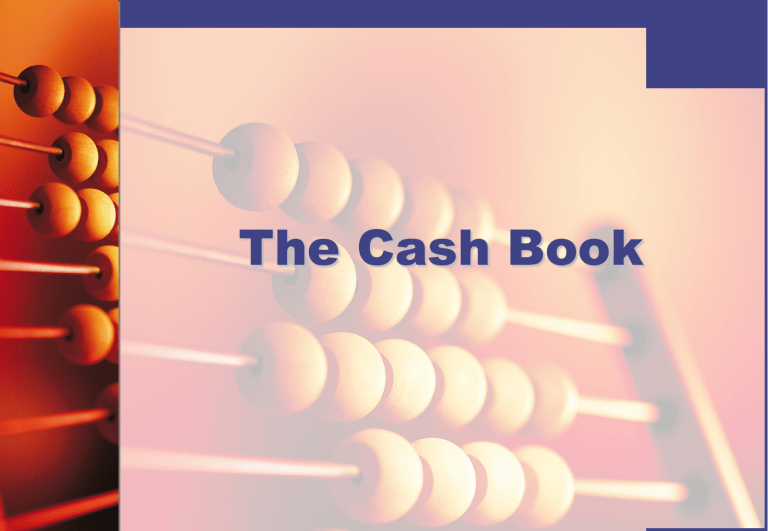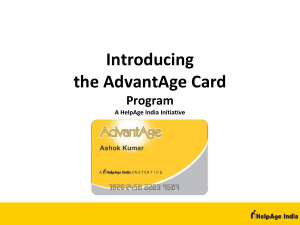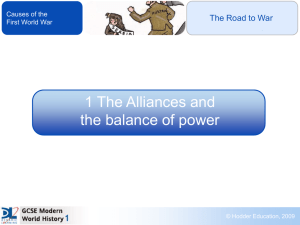The Cash Book

The Cash Book
The cash book is:
a book of prime entry
part of the double-entry system
the cash and bank accounts brought together
© Hodder Education 2008
The two-column cash book
The cash book is set out so that the:
debit columns for cash and bank are side by side
credit columns for cash and bank are also side by side
© Hodder Education 2008
The folio column
This column is used to identify the name of the ledger and account number where the corresponding part of the double entry has been entered.
Using a folio column speeds up the process of finding the opposite entry in the ledgers.
© Hodder Education 2008
Two-column cash book
The layout
Cash book
Folio Cash Bank Date Details Date Details Folio Cash Bank
© Hodder Education 2008
Example
Complete the two-column cash book for the following:
1 March Balance brought down from last month: cash £325; bank £8,640.
2 March Paid insurance £2,000 by cheque.
3 March Cash sales £600.
4 March Purchases by cheque £3,250.
5 March R Hodge paid us £4,250 by cheque.
6 March Bought stationery £40, paying by cash.
7 March Paid wages by cheque £1,350.
8 March P Wilson paid us £600 for goods previously bought on credit.
9 March Received £2,000 owing from A Sumner.
10 March Paid rent £300 by cash.
© Hodder Education 2008
Date Details
01/03 Balance b/d
Cash book
Folio
Cash Bank Date Details
Folio
Cash Bank
325 8,640 02/03 Insurance GL 6 2,000
03/03 Sales GL 1 600 04/03 Purchases PL 2 3,250
05/03 R Hodge
08/03 P Wilson
SL 2
SL 3
09/03 A Sumner SL 5
4,250 06/03 Stationery GL 4
600 07/03 Wages GL 9
40
1,350
2,000 10/03 Rent
11/03 Balance c/d
GL 3 300
585 8,890
925 15,490 925 15,490
© Hodder Education 2008
Tasks
Complete Question 1 on task sheet.
Complete Questions 1 –14 from text book,
Chapter 10.
© Hodder Education 2008
Three-column cash book
The three-column cash book incorporates an additional column at each side for discounts.
There are two types of discounts but only one kind are entered in the double-entry system.
© Hodder Education 2008
Discounts
1. Trade discounts
These are discounts given to companies who trade in the same area or for bulk buying.
They are not recorded in the doubleentry system.
© Hodder Education 2008
Example: trade discount
Goods normally sell at retail price of £250 each.
The manufacturer sells them to the retailer at a
20% trade discount for buying 10.
The discount is recorded on the invoice
£250 × 10 = 2,500 – 20% (£500) = £2000.
£2,000 is the figure that is used in the doubleentry books.
© Hodder Education 2008
Discounts
2. Cash discounts
These are discounts given for early settlement of an invoice.
They are given to encourage early payment.
© Hodder Education 2008
These discounts are recorded in the doubleentry system as:
Discounts allowed – discounts given to debtors when they pay their accounts early.
Discounts received – discounts received by a business from its suppliers when they pay their accounts quickly.
© Hodder Education 2008
Discounts
The discount columns in the cash book are memorandum columns.
At the end of the period they are totalled and the total is transferred into the discounts allowed account and discounts received account in the general ledger.
© Hodder Education 2008
The three-column cash book
Discount columns = memorandum columns.
The discount columns are not part of the doubleentry system.
These columns are totalled and transferred to the discounts allowed account and discounts received accounts in the general ledger.
© Hodder Education 2008
Contra
A transaction that appears on both the debit and credit sides of the account is called a contra entry.
For example, when cash is taken out of the cash account and put into the bank account, then both entries will be in the cash book.
© Hodder Education 2008
Three-column cash book
Cash Book
Date Details Folio Disc Allowed Cash Bank Date Details Folio Disc Received Cash Bank
© Hodder Education 2008
Enter the following transactions in the three-column cash book of
William Buck. Balance off the cash book and show the discounts accounts in the general ledger.
1 July Balances brought forward: Cash £230; Bank 4,560.
2 July Cash sales £450.
3 July The following debtors paid their accounts by cheque each deducting a 5% cash discount: R Jenn £460, S Benny £620 and
J Hacker £540.
4 July Paid rent by cheque £700.
5 July Paid wages by cheque £1,300.
6 July We paid the following accounts by cheque, in each case deducting a 2% cash discount: F Jepson £300, D Hudson £400,
E Butler £600.
7 July Transferred £500 cash to the bank account.
8 July Bought stationery £60, paying cash.
© Hodder Education 2008
Date Details
1/7
2/7
3/7
3/7
3/7
7/7
Balances b/d
Sales
R Jenn
S Benny
J Hacker
Cash
GL 1
SL3
SL4
SL8
C
Folio
Cash Book
Disc
Allow Cash
23
31
42
96
Bank Date Details
230 4,560 4/7
450 5/7
437 6/7
589 6/7
500
498 6/7
7/7
8/7
9/7
1,180 6,084
Rent
Wages
F Jepson
D Hudson
E Butler
Bank
Stationery balance c/d
Folio
GL 2
GL3
PL2
PL5
PL6
C
GL8
Disc
Rec’d Cash Bank
6
8
12
700
1,300
294
392
588
500
60
620 2,810
26 1,180 6,084
© Hodder Education 2008
9/7 Cash book
Discounts allowed
96
Discounts received
9/7 Cash book 26
© Hodder Education 2008
Bank overdraft
A bank overdraft is when a business has taken more money out of its bank account than it has deposited.
If this has occurred then the balance b/d will be shown on the credit side of the account.
© Hodder Education 2008
For example, if a business on 1 November has a bank overdraft of £1,200, and a cash balance of
£330, then the opening balances in the cash book would appear as follows:
Date Details
1/11 balance b/d
Cash Book
Folio Cash Bank Date Details
330 1/11 balance b/d
Folio Cash Bank
1,200
© Hodder Education 2008
Tips
If the balance b/d on the bank is a credit then it is a bank overdraft.
You can never have a balance b/d on the credit side of the cash account (it is impossible to physically spend more cash than you have).
Take care with discounts: trade discounts do not appear in the cash book or double-entry accounts.
Cash discounts do appear in the cash book: these are discounts given for early settlement, not necessarily for cash payments.
© Hodder Education 2008
Tasks
Complete Question 2 from task sheet.
Complete Questions 1 –6, Chapter 11 of text book.
© Hodder Education 2008








